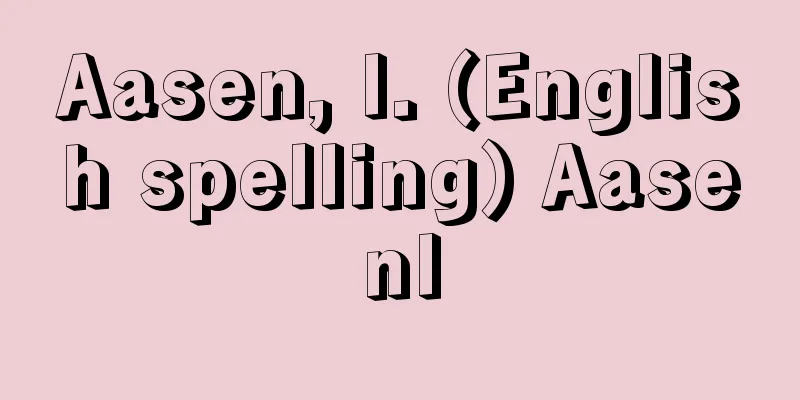Kochi Plain

|
An alluvial plain in the central part of Kochi Prefecture facing Tosa Bay. It stretches for about 40 km from east to west from Teyui, Yasucho, Konan City on the eastern end to the Nagoya Tunnel in Tosa City on the western end, and is bounded in the north by the Shorenji Plateau and the Irazu Mountains. It is divided into the Kacho Plain downstream of the Monobe River in the east, the Kochi Plain in the narrow sense downstream of the Kokubu River and Kagami River in the center, and the Takaoka Plain and Hirooka Plain (Haruno Plain) downstream of the Niyodo River in the west, with isolated hills and low-lying mountain ranges separating the plains. The alluvial fan-shaped Kocho Plain is relatively dry, and in the early days of the Tosa Domain administration, the regent Nonaka Kenzan constructed the Yamada Weir and irrigation channels, which led to the development of rice paddies. Since the mid-Edo period, double rice cropping has been widely practiced, and currently, in addition to rice, the cultivation of forced vegetables, fruit trees, and flowers is thriving. The central Kochi Plain was once home to Urado Bay, but many areas have become land due to river sedimentation and reclamation since the Sengoku period. The area around the bay is low and humid, and about 15 square kilometers of it subsided during the 1946 Nankai earthquake. The west side of the bay is the city of Kochi, and the east side is a rice paddy area, and greenhouse horticulture is popular on the coastal sand dunes. In the Takaoka Plain and Hirooka Plain, greenhouse horticulture for watermelons and cucumbers is popular, with vinyl greenhouses being prominent, and rush cultivation is also carried out in the low-lying wetlands. There are five cities and two towns in the plain, and more than 50% of the prefecture's population is concentrated there. In addition to Kochi City, other well-known towns that originated as towns in the early modern period include Gomen (Nankoku City), Yamada (Kami City), Takaoka (Tosa City), Noichi and Akaoka (Konan City), and today the entire plain is within commuting distance of Kochi City, and residential development is progressing in many areas. [Masaki Hisahito] [References] | | | | |Source: Shogakukan Encyclopedia Nipponica About Encyclopedia Nipponica Information | Legend |
|
高知県中央部、土佐湾に臨む沖積平野。東端の香南(こうなん)市夜須(やす)町手結(てい)から西端の土佐市名古屋トンネルまで東西約40キロメートルに及び、北は正蓮寺(しょうれんじ)高原や不入(いらず)山脈で画される。東部の物部(ものべ)川下流の香長平野(かちょうへいや)、中央の国分(こくぶ)川、鏡(かがみ)川下流の狭義の高知平野、西部の仁淀(によど)川下流の高岡平野、弘岡平野(ひろおかへいや)(春野平野)に分かれ、平野間は孤立丘陵や低平な山脈によって画されている。扇状地性の香長平野は比較的高燥で、土佐藩政初期に執政野中兼山(けんざん)によって山田堰(せき)や灌漑(かんがい)水路が建設され水田化が進んだ。江戸時代中期から水稲二期作が広く行われ、現在は米作のほか、促成野菜、果樹、花卉(かき)などの栽培が盛ん。中央の高知平野は、かつては浦戸(うらど)湾が内陸に広がっていたが、河川の堆積(たいせき)作用と戦国時代以後の干拓によって陸化した所が多い。湾の周辺は低湿で、1946年(昭和21)南海地震の際には約15平方キロメートルが地盤沈下した。湾の西側は高知市街地、東側は水田地帯が広がり、海岸の砂丘地では施設園芸が盛ん。高岡平野、弘岡平野ではスイカ、キュウリの施設園芸が盛んで、ビニルハウスが目だち、低湿地ではイグサ栽培も行われている。 平野内には5市2町があり、県人口の50%以上が集中する。高知市のほか、近世在町に起源する後免(ごめん)(南国(なんこく)市)、山田(香美(かみ)市)、高岡(土佐市)、野市・赤岡(香南市)などが知られ、今日では平野全域が高知市への通勤圏となっていて、各地で宅地化が進んでいる。 [正木久仁] [参照項目] | | | | |出典 小学館 日本大百科全書(ニッポニカ)日本大百科全書(ニッポニカ)について 情報 | 凡例 |
>>: Land consolidation - Kochisei-ri
Recommend
Madder (Western madder) - Madder (English spelling)
A perennial plant of the Rubiaceae family cultivat...
Fire-burning - Ohitaki
…It is also written as Ohitsuki. It is a fire fes...
Above the clouds - Unjo
〘Noun〙 (formerly "unsho")①Above the clou...
Genkai - Genkai
A Japanese dictionary. Edited by Otsuki Fumihiko,...
spermata
…He is also famous as a teacher and friend of the...
Thracian language - Thracian (English spelling)
An Indo-European language spoken in Thrace in anci...
cave bear
…The American black bear migrated from Asia in th...
Color child - Iroko
〘 noun 〙 A type of kagema. A young Kabuki actor wh...
Turkmen - Turkmen (English spelling)
It is one of the Turkic languages. It is spoken b...
"Image Factory"
...Following this, German theater scholar B. Dieb...
Ludwigia epilobioides (English name) Ludwigiaepilobioides
…[Takemi Shimizu]. . … *Some of the terminology t...
Kinoshita Riverbank
…Located on the south bank of the Tone River, the...
e-mail - e-mail
E-mail is like a letter exchanged over a network. ...
Village
…(1) farmstead, homestead: the isolated manor hou...
warp and weft ikat (English spelling) warpandweftikat
...the simplest technique for making ikat threads...





![Yokaichiba [city] - Yokaichiba](/upload/images/67cd164850567.webp)



